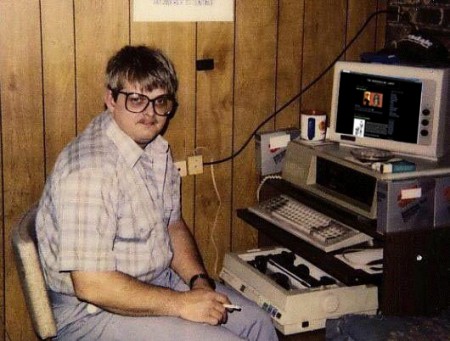 * IT crowd as in the british sitcom
* IT crowd as in the british sitcomExpansion Card
Also known as an add-on card, internal card or interface adapter, an expansion card is an electronic board or card added in a desktop computer or other non-portable computer to give that computer a new ability, such as the ability to connect to another computer using a network cable. Below is a list of expansion cards that could be installed in a an available expansion slot. Interface card (ATA / Bluetooth / EIDE / IDE / Parallel / RISC / SCSI /Serial / USB) Modem MPEG Decoder Network Card Sound Card Video Card Video capture card
Network Interface Card (NIC)
Network Card
Sound Card
Video Card
Video capture card
Plug & Play
Or more commonly known in the IT world as 'PnP' is a capability developed by Microsoft for its Windows 95 and later operating systems that gives users the ability to plug a device into a computer and have the computer recognize that the device is there. The user doesn't have to tell the computer. In many earlier computer systems, the user was required to explicitly tell the operating system when a new device had been added. Microsoft made Plug and Play a selling point for its Windows operating systems. A similar capability had long been built into Macintosh computers.
Sockets
Motherboards are subcategorized by the type of processor socket they have. The processor socket (also called a CPU socket) is the connector on the motherboard that houses a CPU and forms the electrical interface and contact with the CPU. Processor sockets use a pin grid array (PGA) where pins on the underside of the processor connect to holes in the processor socket.
Chips
A small piece of semiconducting material (usually silicon) on which an integrated circuit is embedded. A typical chip is less than ¼-square inches and can contain millions of electronic components (transistors). Computers consist of many chips placed on electronic boards called printed circuit boards.
There are different types of chips. For example, CPU chips (also called microprocessors) contain an entire processing unit, whereas memory chips contain blank memory.
Chips come in a variety of packages. The three most common are:
DIPs : Dual in-line packages are the traditional buglike chips that have anywhere from 8 to 40 legs, evenly divided in two rows.
PGAs : Pin-grid arrays are square chips in which the pins are arranged in concentric squares.
SIPs : Single in-line packages are chips that have just one row of legs in a straight line like a comb.
In addition to these types of chips, there are also single in-line memory modules (SIMMs), which consist of up to nine chips packaged as a single unit.
Slots
There are different types of chips. For example, CPU chips (also called microprocessors) contain an entire processing unit, whereas memory chips contain blank memory.
Chips come in a variety of packages. The three most common are:
DIPs : Dual in-line packages are the traditional buglike chips that have anywhere from 8 to 40 legs, evenly divided in two rows.
PGAs : Pin-grid arrays are square chips in which the pins are arranged in concentric squares.
SIPs : Single in-line packages are chips that have just one row of legs in a straight line like a comb.
In addition to these types of chips, there are also single in-line memory modules (SIMMs), which consist of up to nine chips packaged as a single unit.
Slots
An opening in a computer where you can insert a printed circuit board. Slots are often called expansion slots because they allow you to expand the capabilities of a computer. The boards you insert in expansion slots are called expansion boards or add-on boards.
Do not confuse slots with bays. Bays are sites within the computer where you can install disk drives. Typically, slots are in the back of the computer and bays are in the front.
Bust lines ?
A collection of wires through which data is transmitted from one part of a computer to another. You can think of a bus as a highway on which data travels within a computer. When used in reference to personal computers, the term bus usually refers to internal bus. This is a bus that connects all the internal computer components to the CPU and main memory.
Do not confuse slots with bays. Bays are sites within the computer where you can install disk drives. Typically, slots are in the back of the computer and bays are in the front.
Bust lines ?
A collection of wires through which data is transmitted from one part of a computer to another. You can think of a bus as a highway on which data travels within a computer. When used in reference to personal computers, the term bus usually refers to internal bus. This is a bus that connects all the internal computer components to the CPU and main memory.
...Thats all for today, stay tuned for more facts on IT


